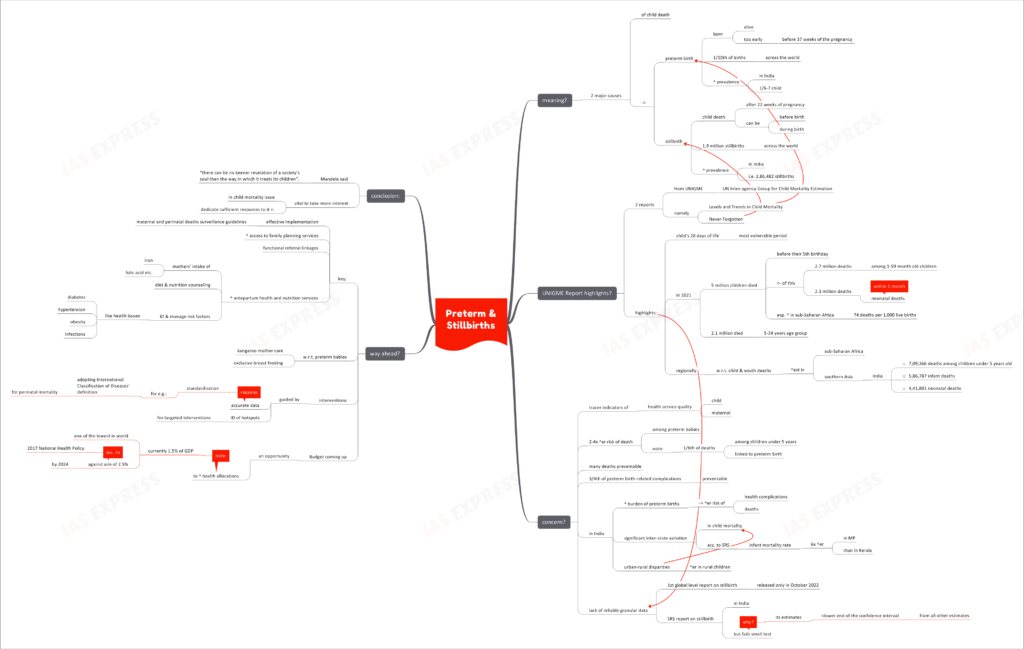Preterm & Stillbirths- UNIGME Report Highlights

From Current Affairs Notes for UPSC » Editorials & In-depths » This topic
IAS EXPRESS Vs UPSC Prelims 2024: 85+ questions reflected
Recently, 2 global reports were released, on stillbirths and child mortality. The report highlighted that most of the 5.0 million child deaths in 2021 were preventable. This is a wakeup call for India to consider whether enough is being done to ensure child survival and health.

What do the terms mean?
- There are 2 major causes of child death:
- Preterm birth
- Stillbirth
Preterm birth:
- When a child is born alive but too early i.e. before the 37 weeks of the pregnancy are completed, it is referred to as a preterm birth.
- 1/10th of births across the world is a preterm birth.
- India has a high prevalence of preterm birth, with 1 in every 6-7 child being born preterm.
Stillbirth:
- When a child dies after 22 weeks of pregnancy it is referred to as a stillbirth. This can occur before the birth or during the birth.
- In 2021, there were some 1.9 million stillbirths across the world.
- In India, 2021 saw 2,86,482 stillbirths.
What are the UNIGME reports’ highlights?
The UNIGME/ United Nations Inter-agency Group for Child Mortality Estimation released 2 reports:
- Levels and Trends in Child Mortality- a report on child mortality
- Never Forgotten- a report on stillbirths
Some of the major highlights of the reports:
- In 2021, 5 million children died across the world before their 5th birthday.
- More than half these deaths (2.7 million) occurred among 1-59 month old children.
- The remaining 2.3 million deaths were neonatal deaths i.e. within the 1st month of life.
- Under-5 death rate was especially high in sub-Saharan Africa (74 deaths per 1,000 live births)
- The report identified that a child’s 28 days of life is the most vulnerable period for survival.
- Among the 5-24 years age group, 2.1 million died in 2021.
- More children and youth died in sub-Saharan Africa and southern Asia than in all other regions.
- India saw:
- 7,09,366 deaths among children under 5 years old
- 5,86,787 deaths among children before their 1st birthday (infant deaths)
- 4,41,801 deaths among children in their 1st month (neonatal deaths)
Why is this a concern?
- Preterm and stillbirth numbers are sensitive ‘tracer indicators’ of a country’s maternal and child health services quality.
- The risk of death among preterm babies is 2-4 times higher than among babies born after the full term of gestation. According to studies, 1/6th of deaths among children under 5 years old is linked to preterm birth.
- As pointed out by the report, many of these deaths are preventable. Notably, 3/4th of preterm birth-related complications are preventable.
- Given India’s high burden of preterm births, the children here are at a higher risk of health complications and mortality.
- In India, there is a significant inter-state variation in child mortality. For instance, the September 2022 Sample Registration System showed that Madhya Pradesh a 6-fold higher infant mortality rate (mortality/ 1,000 live births) than Kerala.
- There is also urban-rural disparities in child mortality trends. Rural children of every age subgroup have a higher mortality rate than urban children.
- A lack of reliable granular data is a key concern.
- Though countries have improved their child mortality tracking mechanisms, they are still lacking sufficient data on stillbirths and preterm births.
- The 1st global level report on stillbirth was released only in October 2022.
- With respect to India, the SRS report on stillbirth exists, but it fails the ‘smell test’.
- Its estimates of stillbirths are much lesser than even the lower end of the confidence interval from all other estimates.
What is the way ahead?
- The unacceptably high prevalence of preterm and stillbirths in India calls for urgent interventions. This is especially so, given how preventable these issues are.
- They key to reducing stillbirths and preterm births are:
- Effective implementation of maternal and perinatal deaths surveillance guidelines
- Improved access to family planning services
- Maintenance of functional referral linkages
- Improved antepartum health and nutrition services- focusing on
- Iron, folic acid and other nutrients intake by the mothers
- Diet and nutrition counselling
- Identification and management of risk factors, etc. For e.g., managing health issues like diabetes, obesity, hypertension and infections.
- When it comes to preterm babies, several measures can help improve their chances of survival:
- Kangaroo mother care
- Exclusive breastfeeding, etc.
- These interventions would be more effective when guided by accurate data on prevalence of preterm and stillbirths. This will help identify hotspots for targeted intervention.
- The reporting can be standardized by adopting International Classification of Diseases’ definition for perinatal mortality.
- The Union Budget for 2023-24 is to be presented in the Parliament in the coming weeks. In this light, the government must consider increasing allocation for healthcare.
- The current allocation for health sector is still around 1.5% of GDP, while the 2017 National Health Policy sought to achieve a health sector investment of 2.5% of GDP by 2025.
- Despite the unfortunate number of child deaths, India’s health investments continue to be among the world’s lowest.
Conclusion:
Mandela said “there can be no keener revelation of a society’s soul than the way in which it treats its children”. It is vital for the government to take more interest in the country’s child mortality prevalence and dedicate sufficient resources to address the issue.
Practice Question for Mains:
What are preterm and still births? Discuss the necessity of addressing these issues in our quest to reduce child mortality. (250 words)
If you like this post, please share your feedback in the comments section below so that we will upload more posts like this.

